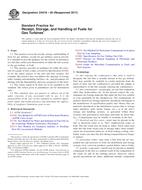We need your consent to use the individual data so that you can see information about your interests, among other things. Click "OK" to give your consent.
ASTM D525-12a
Standard Test Method for Oxidation Stability of Gasoline (Induction Period Method) (Includes all amendments And changes 12/12/2019).
Automatically translated name:
Standard Test Method for Oxidation Stability of Gasoline (Induction Period Method)
STANDARD published on 1.9.2012
The information about the standard:
Designation standards: ASTM D525-12a
Note: WITHDRAWN
Publication date standards: 1.9.2012
SKU: NS-30448
The number of pages: 8
Approximate weight : 24 g (0.05 lbs)
Country: American technical standard
Category: Technical standards ASTM
The category - similar standards:
Annotation of standard text ASTM D525-12a :
Keywords:
breakpoint, gasoline, induction period, oxidation stability, ICS Number Code 75.160.20 (Liquid fuels)
Additional information
| Significance and Use | ||||||||
|
The induction period may be used as an indication of the tendency of motor gasoline to form gum in storage. It should be recognized, however, that its correlation with the formation of gum in storage may vary markedly under different storage conditions and with different gasolines. |
||||||||
| 1. Scope | ||||||||
|
1.1 This test method covers the determination of the stability of gasoline in finished form only, under accelerated oxidation conditions. (WarningThis test method is not intended for determining the stability of gasoline components, particularly those with a high percentage of low boiling unsaturated compounds, as these may cause explosive conditions within the apparatus. However, because of the unknown nature of certain samples, the pressure vessel assembly shall include a safety burst-disc in order to safeguard the operator.) Note 1—For measurement of oxidation stability of gasoline by measurement of potential gum, refer to Test Method D873, or IP Test Method 138. Note 2—The precision data were developed with gasolines derived from hydrocarbon sources only without oxygenates. 1.2 The accepted SI unit of pressure is the kilo Pascal (kPa), and of temperature is °C. 1.3 WARNINGMercury has been designated by many regulatory agencies as a hazardous material that can cause central nervous system, kidney and liver damage. Mercury, or its vapor, may be hazardous to health and corrosive to materials. Caution should be taken when handling mercury and mercury containing products. See the applicable product Material Safety Data Sheet (MSDS) for details and EPA’s websitehttp://www.epa.gov/mercury/faq.htmfor additional information. Users should be aware that selling mercury and/or mercury containing products into your state or country may be prohibited by law. 1.4 This standard does not purport to address all of the safety concerns, if any, associated with its use. It is the responsibility of the user of this standard to establish appropriate safety and health practices and determine the applicability of regulatory limitations prior to use. |
||||||||
| 2. Referenced Documents | ||||||||
|
Similar standards:
Historical
1.10.2011
Historical
1.12.2011
Historical
1.10.2010
Historical
15.6.2013
Historical
1.11.2012
Historical
1.8.2010
We recommend:
Technical standards updating
Do you want to make sure you use only the valid technical standards?
We can offer you a solution which will provide you a monthly overview concerning the updating of standards which you use.
Would you like to know more? Look at this page.



 ASTM D4418-00(2011)..
ASTM D4418-00(2011).. ASTM D4529-01(2011)..
ASTM D4529-01(2011).. ASTM D4539-10
ASTM D4539-10 ASTM D4682-13
ASTM D4682-13 ASTM D473-07(2012)..
ASTM D473-07(2012).. ASTM D4737-10
ASTM D4737-10
 Cookies
Cookies
